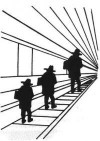Цитата из книги «Думай медленно... решай быстро» Даниэль Канеманпоказать все Добавить
The lesson is clear: estimates of causes of death are warped by media coverage. The coverage is itself biased toward novelty and poignancy. The media do not just shape what the public is interested in, but also are shaped by it. Editors cannot ignore the public’s demands that certain topics and viewpoints receive extensive coverage. Unusual events (such as botulism) attract disproportionate attention and are consequently perceived as less unusual than they really are. The world in our heads is not a precise replica of reality; our expectations about the frequency of events are distorted by the prevalence and emotional intensity of the messages to which we are exposed.
The estimates of causes of death are an almost direct representation of the activation of ideas in associative memory, and are a good example of substitution.
Наши действия и поступки определены нашими мыслями. Но всегда ли мы контролируем наше мышление? Нобелевский лауреат Даниэль Канеман объясняет, почему мы подчас совершаем нерациональные поступки и как мы принимаем неверные решения. У нас имеется две системы мышления. «Медленное» мышление включается, когда мы решаем задачу или выбираем товар в магазине. Обычно нам кажется, что мы уверенно контролируем эти процессы, но не будем забывать, что позади нашего сознания в фоновом режиме постоянно...
